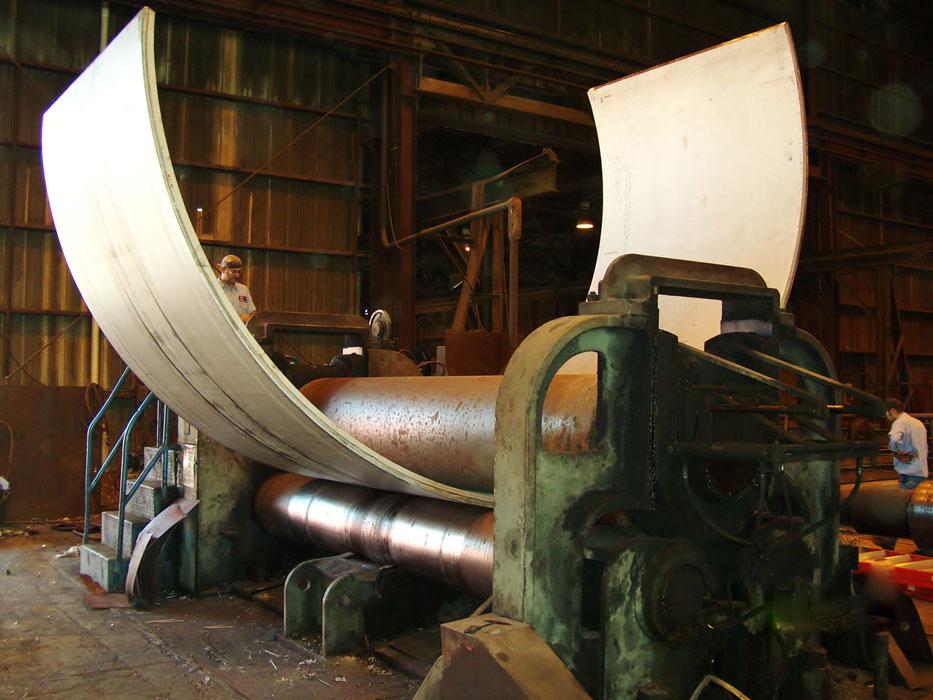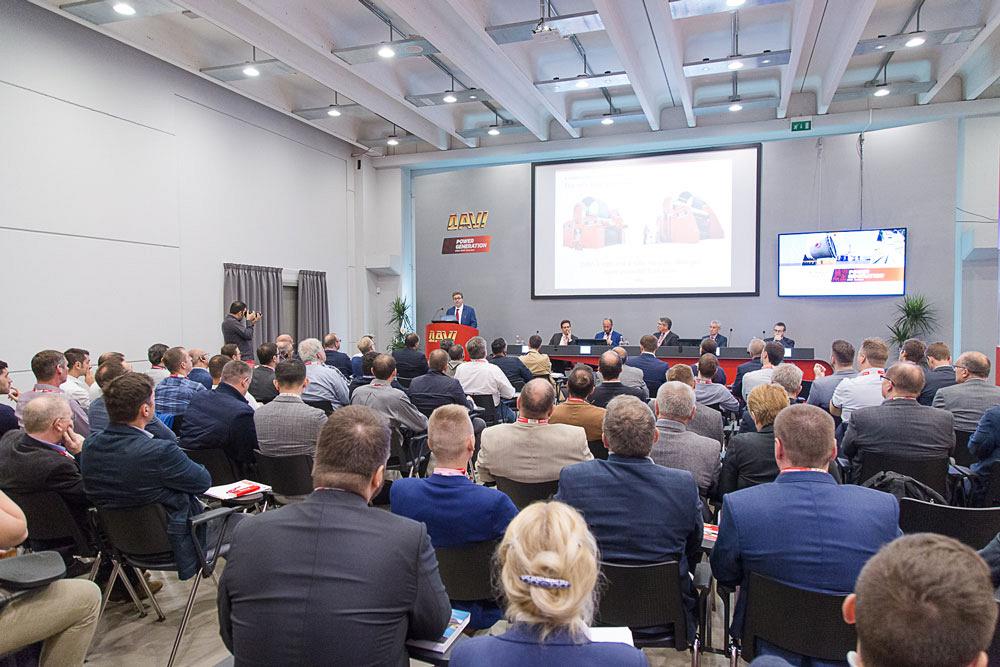Contributing Editor
- FMA
- The Fabricator
- FABTECH
- Canadian Metalworking
Categories
- Additive Manufacturing
- Aluminum Welding
- Arc Welding
- Assembly and Joining
- Automation and Robotics
- Bending and Forming
- Consumables
- Cutting and Weld Prep
- Electric Vehicles
- En Español
- Finishing
- Hydroforming
- Laser Cutting
- Laser Welding
- Machining
- Manufacturing Software
- Materials Handling
- Metals/Materials
- Oxyfuel Cutting
- Plasma Cutting
- Power Tools
- Punching and Other Holemaking
- Roll Forming
- Safety
- Sawing
- Shearing
- Shop Management
- Testing and Measuring
- Tube and Pipe Fabrication
- Tube and Pipe Production
- Waterjet Cutting
Industry Directory
Webcasts
Podcasts
FAB 40
Advertise
Subscribe
Account Login
Search
Let’s get rollin’
Plate roller manufacturer DAVI hosted a power-generation seminar at its headquarters in Cesena, Italy, bringing together global experts to discuss tech solutions in energy production
- By Lindsay Luminoso
- January 18, 2019
- Article
- Roll Forming
Editor’s Note: This article originally appeared in the December 2018 issue of Canadian Fabricating & Welding.
The world’s power generating sources have shifted over the past few years. According to a 2017 Electrical Statistical Review by BP plc, coal remains the world’s dominant source of power, accounting for 38.1 percent. Natural gas (23.2 percent) and hydroelectricity (15.9 percent) hold second and third positions, respectively. However, it was renewables that saw the biggest growth, reaching 8.4 percent, a jump of over 6 percent since 2007. With a changing power generation sector and a significant spike in renewable energy sources, more manufacturers are expanding their capabilities to be able to compete in emerging markets. And with that comes a shift in production and rising to new challenges.
This was the message that more than 75 fabricators representing 24 countries around the world learned at the 2018 Power Generation Seminar, hosted by plate rolling equipment manufacturer DAVI at its headquarters in Cesena, Italy. The seminar brought together tech experts from DAVI, HGG, Pema, Messer, and PAMA, all co-organizers of the event, to discuss the challenges facing fabricators in the power generation sector, focusing on technology for fabricating heavy plate, including the latest in automatic cutting 3D systems; automation for welding, plate rolling, boring-milling machines; and oxyfuel, plasma, and laser cutting machines for this segment.
“We all encounter a lot of the same issues, whether it be from manufacturing in the wind tower industry, offshore, structural components to ASME vessel work, pressure vessels, and pressure pipe,” said Aaron Poe, manufacturing engineer at Taylor Forge Engineered Systems, Paola, Kan. “It’s all the same. We just are fighting it in different ways. And for me, it’s unique to hear other people’s stories and the way that they’re achieving things and learn from them.”
The event focused on finding the appropriate tools for five areas of power generation: vessels, heat exchangers, hydropower, offshore oil and gas (jackets), and wind energy.
For Poe, one of the most interesting things he learned at the event was just how similar large offshore platform structural components and wind tower manufacturing processes are to the company’s pressure vessel and pressure piping manufacturing and fabrication processes.
Real-world Example
Taylor Forge Engineered Systems started in Cicero, Ill., in the early 1900s and centered around pipe and flange manufacturing. Over the years the company has changed hands, but in 1984 Taylor Forge was established under its current ownership; they expanded and grew the business to what it is today. The company primarily fabricates pressure vessels and pressure piping, specifically heat exchangers, launchers, receivers, extruded headers, and a flagship product called a slug catcher.
“Our markets are typically cyclical, but it seems to be pretty steady at this point,” Poe explained. “Historically we export 50-70 percent of what we produce, but oil and gas production has kept most of our work in North America recently. When oil hit under $30 per barrel in 2016, things dropped off quite a bit. We didn’t see many of the big, international orders that usually go to the Middle East and other parts of the world. But when the domestic market came back up we focused on that. The international market is poised for a substantial comeback. So I think that’s a good indicator that the market is better, at least globally, for some of our work.”
When it comes to fabricating pressure vessels and heat exchangers, for example, the process generally includes shot blasting, cutting, rolling, fitting, welding, heat treatment, and coating. Typically, the rolled plates tend to have the following characteristics: high-grade materials, small diameters, high thickness, hot rolling (if required), possible edge bending on a press, and low volume.
Most of Taylor Forge’s work is focused on plate rolling, welding, and a unique extrusion process. A primary portion of the work begins when the plate is received. The company has hundreds of thousands of pounds of plate inventory of its own stock chemistry. The majority of raw material comes in as plate and then it is precut, preformed, rolled into shape, and then welded.

DAVI’s facility features several plate and angle rolls available for immediate delivery to customers.
“We have two primary plate bending rolls, one pyramid and one single pinch-type roll,” said Poe. “Our plate rolling process could benefit from updated equipment and improved roll designs. In general, pyramid-type rolls are a thing of the past in our industry and it requires that we do other subsequent preforming operations that could be eliminated by updated designs.”
The pyramid-type roll requires extensive prebending. By eliminating this extra process, Taylor Forge’s work flow could be drastically changed.
“I think that is a key driver for me when I look at other equipment and really understand what the capabilities are and how it would benefit us,” Poe added.
With certain bending rolls and a company’s process, the plate may need to be cut to an extended length to compensate for the inability of the machine to prebend the plate ends, which leads to a significant amount of scrap material and wasted time. Not all machines have pre-bending capabilities, but for Poe, this is a key feature that he looks for in new machines.
“The ASME and pressure vessel business has roundness requirements,” said Poe. “Through the [live rolling] demonstration and facility tour, I saw equipment capable of consistently controlling the rolling process and re-rolling process after welding (where needed) to meet the ASME requirements. Having equipment with advanced capabilities can really put you on the map as a manufacturer.”
Poe added that through attending the event, he had an unintended revelation with regards to long seam weld bevel preparation. The industry partner Pema presented its bevel machining for seminarrow groove welding.
“This is very good technology and equipment that is very complementary to plate rolling and fabrication.”
North of the Border
The seminar focused on solving real-world challenges and bringing together technologies to help solve day-to-day challenges. Like Taylor Forge, Canadian companies are faced with changing market trends and adapting to meet new realities.
According to Natural Resources Canada, Canada is a world leader in the production and use of energy from renewable resources—hydro, wind, solar, and biomass. Sixty-six percent of Canada’s electricity comes from renewables (hydro and non-hydro renewables). Of all sources, hydro has the highest share of generation at 59 percent; followed by nuclear at 15 percent; coal at 9 percent; gas, oil, and others at 10 percent; and non-hydro renewables at 7 percent.
There is also significant opportunity in Canada when it comes to fabricating for the power generation sector. Many of the country’s nuclear power plants are up for refurbishment, including Bruce Power, Tiverton, Ont., and Darlington Nuclear Generation Plant, Darlington, Ont. British Columbia, Alberta, and Quebec all have ongoing hydroelectric projects. The country is also upgrading hydro transmission lines and distribution stations. Prince Edward Island is adding 70 MW of wind energy by 2026. Undoubtedly, more power generation projects will become available as provincial and federal governments continue to invest in clean energy.

Most of Taylor Forge’s work is focused on plate rolling, welding, and a unique extrusion process. The company currently has two primary plate bending rolls, including this Williams & White pyramid-type plate bending roll, and is exploring how new technologies can enhance its plate bending capabilities.
“The Canadian market pretty much mirrors the U.S. market, just on a smaller scale,” said Steve Bonnay, regional sales manager (Canada), DAVI. “We have the oil patch and the United States has the oil patch. We have wind tower and pressure vessel manufacturers, excavator bucket fabricators, and all the rest. We have the same technology, it’s just further between each of those potential customers. I think that that works for and against Canadian companies.”
Bonnay explained that if, for example, you look at a large vessel shop or a wind tower manufacturer in Canada, they typically have a greater geographic footprint to cover. This can be a challenge, too, because when you are fabricating large rail cars, a wind tower section, or a pressure vessel, freight becomes such a huge component of the end user’s price. It’s a blessing and a curse and generally why heavy fabricators tend to focus on local markets.
“That’s where investing in new equipment is vital to help lowering costs,” said Bonnay. “For example, DAVI’s wind tower line—the Smart Line—if, say, a tower shop invested in this new technology, they may not need as many workers and certainly wouldn’t need as much time to roll the plates. Rolls come out more accurate, so the paint adheres better or less reworking is needed prior to painting. All of those things are good indicators where you can cut your costs to compete on a farther-reaching scale.”
The oil and gas segment is rebounding from the crash several years ago, and Bonnay says this is a great opportunity for investing in plate rolling equipment, especially because this industry typically runs thicker, heavier plate. New tech advancements like DAVI’s Smart Line, designed for automatic bending sequence of the conical cans, and large plate rolling machines are well suited for the oil sector right now.
Oil and gas is not the only segment suited for heavy plate rolling machines; nuclear is also significant. Excavator and agriculture equipment, rail cars, and truck trailer manufacturing are big business in Canada for heavy plate rolling. Investing in equipment that enables fabricators to be competitive in these markets is a key driver of success. This is part of the reason that DAVI, HGG, Pema, Messer, and PAMA co-host events like the power generation seminar: to give attendees a wide-ranging view of what it takes to be successful in these markets, including introducing the latest technologies and practical applications that can be taken back to the shop floor to allow fabricators to produce better parts more efficiently.
“Our hope for these events is that by showing attendees what we can do and how we can partner with them when they have a need, we will be on the top of their list to call,” said Bonnay.
For Bonnay, these events are also about bringing awareness to the importance of industry partnerships and finding solutions to real-world problems.
“What impressed me most was on the second day when we visited the warehouse facility,” said Poe. “I could really see the commitment to the [DAVI] products—knowing that they have that many components and spare parts available in stock waiting to support their customers in the field.”
DAVI—Promau Group, www.davi.com
HGG Group, www.hgg-group.com

For Poe, one of the most impressive features of the event was seeing the company’s commitment to its products, knowing that they have many components and spare parts available in stock waiting to support DAVI customers in the field.
Messer Cutting Systems, www.messer-cs.com
PAMA SpA, en.pama.it
Pema Welding Automation, www.pemamek.com
Taylor Forge, www.tfes.com
About the Author

Related Companies
subscribe now

The Fabricator is North America's leading magazine for the metal forming and fabricating industry. The magazine delivers the news, technical articles, and case histories that enable fabricators to do their jobs more efficiently. The Fabricator has served the industry since 1970.
start your free subscription- Stay connected from anywhere

Easily access valuable industry resources now with full access to the digital edition of The Fabricator.

Easily access valuable industry resources now with full access to the digital edition of The Welder.

Easily access valuable industry resources now with full access to the digital edition of The Tube and Pipe Journal.
- Podcasting
- Podcast:
- The Fabricator Podcast
- Published:
- 04/16/2024
- Running Time:
- 63:29
In this episode of The Fabricator Podcast, Caleb Chamberlain, co-founder and CEO of OSH Cut, discusses his company’s...
- Trending Articles
AI, machine learning, and the future of metal fabrication

Employee ownership: The best way to ensure engagement

Steel industry reacts to Nucor’s new weekly published HRC price

Dynamic Metal blossoms with each passing year

Metal fabrication management: A guide for new supervisors

- Industry Events
16th Annual Safety Conference
- April 30 - May 1, 2024
- Elgin,
Pipe and Tube Conference
- May 21 - 22, 2024
- Omaha, NE
World-Class Roll Forming Workshop
- June 5 - 6, 2024
- Louisville, KY
Advanced Laser Application Workshop
- June 25 - 27, 2024
- Novi, MI




























